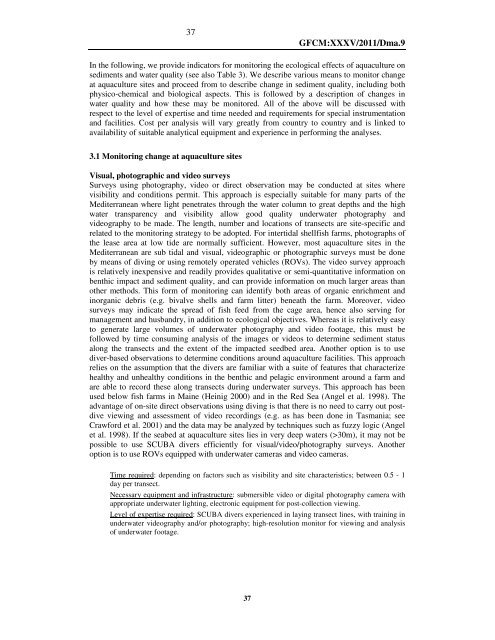Site selection and carrying capacity in Mediterranean ... - FAO Sipam
Site selection and carrying capacity in Mediterranean ... - FAO Sipam
Site selection and carrying capacity in Mediterranean ... - FAO Sipam
You also want an ePaper? Increase the reach of your titles
YUMPU automatically turns print PDFs into web optimized ePapers that Google loves.
37<br />
37<br />
GFCM:XXXV/2011/Dma.9<br />
In the follow<strong>in</strong>g, we provide <strong>in</strong>dicators for monitor<strong>in</strong>g the ecological effects of aquaculture on<br />
sediments <strong>and</strong> water quality (see also Table 3). We describe various means to monitor change<br />
at aquaculture sites <strong>and</strong> proceed from to describe change <strong>in</strong> sediment quality, <strong>in</strong>clud<strong>in</strong>g both<br />
physico-chemical <strong>and</strong> biological aspects. This is followed by a description of changes <strong>in</strong><br />
water quality <strong>and</strong> how these may be monitored. All of the above will be discussed with<br />
respect to the level of expertise <strong>and</strong> time needed <strong>and</strong> requirements for special <strong>in</strong>strumentation<br />
<strong>and</strong> facilities. Cost per analysis will vary greatly from country to country <strong>and</strong> is l<strong>in</strong>ked to<br />
availability of suitable analytical equipment <strong>and</strong> experience <strong>in</strong> perform<strong>in</strong>g the analyses.<br />
3.1 Monitor<strong>in</strong>g change at aquaculture sites<br />
Visual, photographic <strong>and</strong> video surveys<br />
Surveys us<strong>in</strong>g photography, video or direct observation may be conducted at sites where<br />
visibility <strong>and</strong> conditions permit. This approach is especially suitable for many parts of the<br />
<strong>Mediterranean</strong> where light penetrates through the water column to great depths <strong>and</strong> the high<br />
water transparency <strong>and</strong> visibility allow good quality underwater photography <strong>and</strong><br />
videography to be made. The length, number <strong>and</strong> locations of transects are site-specific <strong>and</strong><br />
related to the monitor<strong>in</strong>g strategy to be adopted. For <strong>in</strong>tertidal shellfish farms, photographs of<br />
the lease area at low tide are normally sufficient. However, most aquaculture sites <strong>in</strong> the<br />
<strong>Mediterranean</strong> are sub tidal <strong>and</strong> visual, videographic or photographic surveys must be done<br />
by means of div<strong>in</strong>g or us<strong>in</strong>g remotely operated vehicles (ROVs). The video survey approach<br />
is relatively <strong>in</strong>expensive <strong>and</strong> readily provides qualitative or semi-quantitative <strong>in</strong>formation on<br />
benthic impact <strong>and</strong> sediment quality, <strong>and</strong> can provide <strong>in</strong>formation on much larger areas than<br />
other methods. This form of monitor<strong>in</strong>g can identify both areas of organic enrichment <strong>and</strong><br />
<strong>in</strong>organic debris (e.g. bivalve shells <strong>and</strong> farm litter) beneath the farm. Moreover, video<br />
surveys may <strong>in</strong>dicate the spread of fish feed from the cage area, hence also serv<strong>in</strong>g for<br />
management <strong>and</strong> husb<strong>and</strong>ry, <strong>in</strong> addition to ecological objectives. Whereas it is relatively easy<br />
to generate large volumes of underwater photography <strong>and</strong> video footage, this must be<br />
followed by time consum<strong>in</strong>g analysis of the images or videos to determ<strong>in</strong>e sediment status<br />
along the transects <strong>and</strong> the extent of the impacted seedbed area. Another option is to use<br />
diver-based observations to determ<strong>in</strong>e conditions around aquaculture facilities. This approach<br />
relies on the assumption that the divers are familiar with a suite of features that characterize<br />
healthy <strong>and</strong> unhealthy conditions <strong>in</strong> the benthic <strong>and</strong> pelagic environment around a farm <strong>and</strong><br />
are able to record these along transects dur<strong>in</strong>g underwater surveys. This approach has been<br />
used below fish farms <strong>in</strong> Ma<strong>in</strong>e (He<strong>in</strong>ig 2000) <strong>and</strong> <strong>in</strong> the Red Sea (Angel et al. 1998). The<br />
advantage of on-site direct observations us<strong>in</strong>g div<strong>in</strong>g is that there is no need to carry out postdive<br />
view<strong>in</strong>g <strong>and</strong> assessment of video record<strong>in</strong>gs (e.g. as has been done <strong>in</strong> Tasmania; see<br />
Crawford et al. 2001) <strong>and</strong> the data may be analyzed by techniques such as fuzzy logic (Angel<br />
et al. 1998). If the seabed at aquaculture sites lies <strong>in</strong> very deep waters (>30m), it may not be<br />
possible to use SCUBA divers efficiently for visual/video/photography surveys. Another<br />
option is to use ROVs equipped with underwater cameras <strong>and</strong> video cameras.<br />
Time required: depend<strong>in</strong>g on factors such as visibility <strong>and</strong> site characteristics; between 0.5 - 1<br />
day per transect.<br />
Necessary equipment <strong>and</strong> <strong>in</strong>frastructure: submersible video or digital photography camera with<br />
appropriate underwater light<strong>in</strong>g, electronic equipment for post-collection view<strong>in</strong>g.<br />
Level of expertise required: SCUBA divers experienced <strong>in</strong> lay<strong>in</strong>g transect l<strong>in</strong>es, with tra<strong>in</strong><strong>in</strong>g <strong>in</strong><br />
underwater videography <strong>and</strong>/or photography; high-resolution monitor for view<strong>in</strong>g <strong>and</strong> analysis<br />
of underwater footage.
















